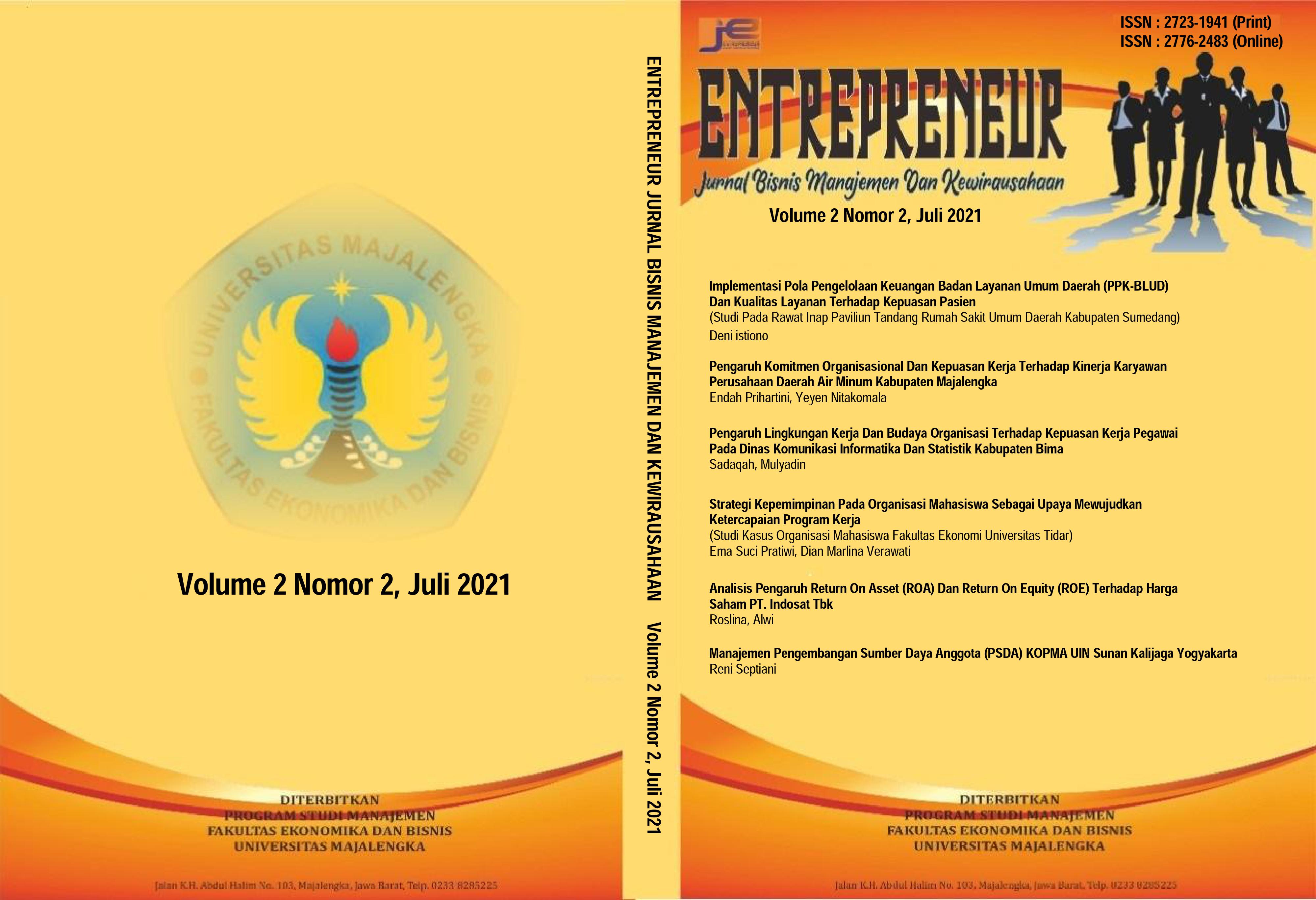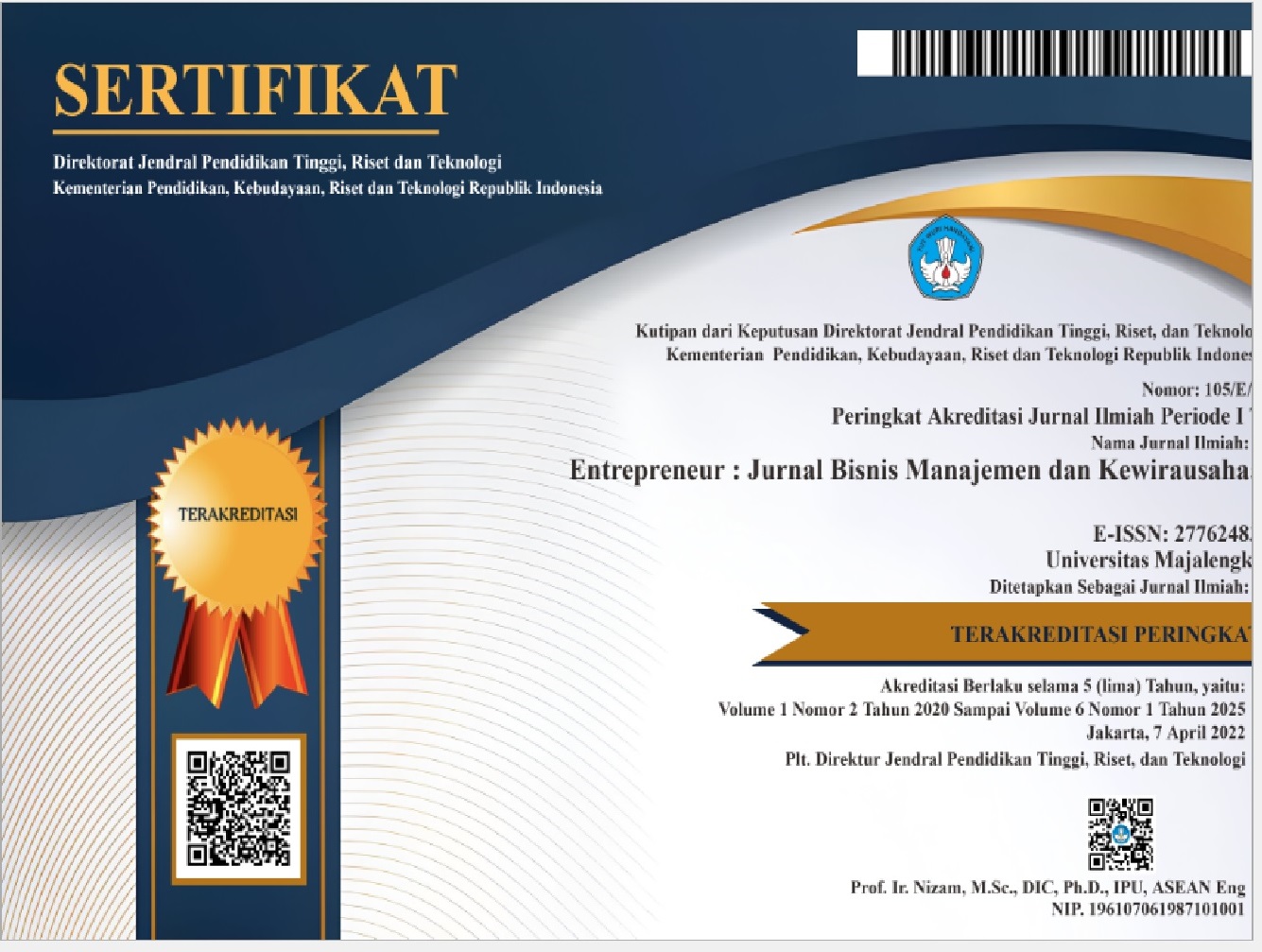Peran Kepuasan Pelanggan Pada Hubungan Kausalitas Antara Kualitas Layanan Terhadap Niat Beralih
(Studi Pada Pengunjung Hotel Fitra Majalengka)
DOI:
https://doi.org/10.31949/entrepreneur.v2i2.1165Abstract
ABSTRACT
This type of research is associative research. This research takes the title: “This type of research is associative research. This research takes the title: "The Role of Customer Satisfaction on the Causality Relationship Between Service Quality and Switch Intention (Study on Fitra Majalengka hotel visitors)”.
The purpose of this study was to determine the partial effect of core service quality and encounter on switching intentions with the mediating factor of customer satisfaction.
The population in this study were all visitors to the Fitra Majalengka hotel. The sampling technique used is purposive sampling. The number of respondents in this study was 120. The data were analyzed using structural equation modeling (SEM) with AMOS 21 software.
The results of this study indicate that 1) core service quality has no effect on switching intentions, 2) encounter service quality has no effect on switching intentions, 3) core service quality has a positive effect on customer satisfaction, 4) encounter service quality has a positive effect on customer satisfaction, 5 ) customer satisfaction has a negative effect on switching intentions, 6) customer satisfaction mediates the negative effect of core service quality on switching intentions, 7) customer satisfaction mediates the negative effect of encounter service quality on switching intentions. An important finding from this study is that it can confirm the concept of EDT in which customer satisfaction becomes a mediating variable between the relationship between core service quality and encounter with switching intentions.
Keywords:
core service quality, encounter service quality, customer satisfaction, switching intentionDownloads
References
Antón, C., Camarero, C., Carrero, M. (2007). The Mediating Effect of Satisfaction on Consumers’ Switching Intention. Psychology & Marketing, 24 (6), 511–538. Doi: 10.1002/mar.20171
Bansal, H. S., Taylor, S. F., James, Y.S. (1999). "Migrating" to New Service Providers: Toward a Unifying Framework of Consumers' Switching Behaviors. Journal of the Academy of Marketing Science, 33 (1), 96-115. Doi: 10.1177/0092070304267928
Baron, R.M. dan Kenny, D.A. (1986). The moderator-mediator variable distinction in social psychological research: conceptual, strategic, and statistical considerations. Journal of Personality and Social Psychology, 51 (6), 1173-1182. Doi: 10.1037/0022-3514.51.6.1173
Bhattacherjee, A., Perols, J., & Sanford, C. (2016). Information Technology Continuance: A Theoretic Extension and Empirical Test. Journal of Computer Information Systems, 49 (1), 17-26. Doi: 10.1080/08874417.2008.11645302
Bitner, M.J., Booms, B.H., Tetreault, M.S. (1990). The service encounter: diagnosing favorable and unfavorable incidents. Journal of Marketing, 54, 71–84.
Clemmer, J. (1990). The three rings of perceived value. Canadian Manager, 15, 12–15.Diakses dari: https://www.thefreelibrary.com/The+three+rings+of+perceived+value.-a09091843
Colgate, M., Lang, B. (2001). Switching barriers in consumer markets: an investigation of the financial services industry. Journal of Consumer Marketing, 18 (4), 332–347. Doi: 10.1108/07363760110393001
Crie, D. (2003). Consumers’ complaint behaviour. Taxonomy, typology and determinants: Towards a unified ontology. Database Marketing & Customer Strategy Management, 11 (1), 60–79. Doi: 10.1057/palgrave.dbm.3240206
Ferdinand, A. (2002). Structural Equation Modelling dalam Penelitian Manajemen, Badan Penerbit Universitas Diponegoro, Semarang.
Ghozali, Imam. (2013). Aplikasi Analisis Multivariate Dengan Program SPSS. Semarang: Badan Penerbit Universitas Diponegoro.
Hair, J.F., Black, W.C., Babin, B.J. and Anderson, R.E. (2010) Multivariate Data Analysis. 7th edn. New York: Pearson.
Han, H., Kim, W., Hyun, S.S. (2010). Switching intention model development: Role of service performances, customer satisfaction, and switching barriers in the hotel industry. International Journal of Hospitality Management, 30, 619–629. Doi: 10.1016/j.ijhm.2010.11.006
Han, H., and Ryu, K. (2012). Key Factors Driving Customers’ Word-of-Mouth Intentions in Full-Service Restaurants: The Moderating Role of Switching Costs. Cornell Hospitality Quarterly, 53 (2), 96–109. Doi: 10.1177/1938965511433599
Huang, W.Y., and Dubinsky, A.J. (2014). Measuring customer pre-purchase satisfaction in a retail setting. The Service Industries Journal. 34, (3), 212-229. Doi: 10.1080/02642069.2013.778249
Jones, M.A., Suh, J. (2000). Transaction-specific satisfaction and overall satisfaction: an empirical analysis. Journal of Service Marketing, 14 (2), 147-159. Doi: 10.1108/08876040010371555
Keaveney, S.M. (1995). Customer switching behavior in service industries: an exploratory study. Journal of Marketing, 59 (2), 71–82. Doi: 10.2307/1252074
Lehto, x.y., Ounjung, P., dan & Gordon, S.E. (2015). Migrating to new hotels: a comparison of antecedents of business and leisure travelers’ hotel switching intentions. Journal of Quality Assurance in Hospitality & Tourism, 16 (3), 235-258. DOI: 10.1080/1528008X.2014.925787.
Liang, L.J., Choi, H.C., Joppe, M. (2018). Exploring the relationship between satisfaction, trust and switching intention, repurchase intention in the context of Airbnb. International Journal of Hospitality Management, 69, 41-48. Doi: 10.1016/j.ijhm.2017.10.015
McDougall, G.H., dan Levesque, T. (2000). Customer satisfaction with services: putting perceived value into the equation. Journal of Services Marketing, 14, (5),392-410. DOI: https://doi.org/10.1108/08876040010340937
Ofori, K.S., Siaw, O.L., Addae, J.A. (2015). Antecedents of customer switching intention in the Ghanaian telecommunications industry. Accounting, 1, 95–108. Doi: 10.5267/j.ac.2015.11.006
Oliver, R.L. (1997). Satisfaction: A Behavioral Perspective on the Consumer. McGraw-Hill, New York.
Oliver, R.L., 1980. A cognitive model of the antecedents and consequences of satisfaction decisions. Journal of Marketing Research, 17 (4), 460–469. Doi: 10.2307/315049
Quach, T.C. (2016). The effects of service quality on Internet Service Provider customers’ behaviour - a mixed methods study. Asia Pacific Journal of Marketing and Logistics. 28 (3). DOI: http://dx.doi.org/10.1108/APJML-03-2015-0039
Quoquab, F., Yasin, N.M., Muhammad, J., Abdullah, N.L., (2018). Antecedents of switching intention in the mobile telecommunications industry: A partial least square approach. Asia Pacific Journal of Marketing and Logistics, 30 (4), 1087-1111. Doi: 10.1108/APJML-06-2017-0121
Shostack, G.L. (1985). Planning the service encounter. In: Czepiel, J., Solomon, M., Surprenant, C. (Eds.), The Service Encounter. Lexington Books, Lexington, MA, 243–254.
Suliyanto. (2018). Metode Penelitian Bisnis. Yogyakarta: CV. Andi Offset.
Andayani, S. A., Sumekar, Y., & Suhaeni, J. S. (2020). Supply chain risk classification shallot agribusiness in the Highland through analytical hierarchy process approach. focus, 8.
Andayani, S. A., & Sumekar, Y. (2020). Prediction analysis model of nira production in arenga pinnata by using adaptive neuro-fuzzy inference system method. Thematics Journal of Botany, 4(2).
Ginanjar, Y., Rahmayani, M. W., & Riyadi, W. (2019). Identifikasi faktor penyebab tingkat audit delay di bursa efek indonesia. Jurnal Kajian Akuntansi, 3(2), 210-222.
Amin, M. A. S. (2020). Communication Activities Seba Baduy Lebak Regency Banten. Budapest International Research and Critics Institute (BIRCI-Journal): Humanities and Social Sciences, 3(1), 73-80.
Amin, M. A. S. (2020). Communication Activities in Mitoni Events in Layansari Village (Study of Communication Ethnography Regarding Communication Activities at the Mitoni Event in Layansari Village, Gandrungmangu District, Cilacap Regency in requesting the safety of Mother and Child). Budapest International Research and Critics Institute-Journal (BIRCI-Journal), 3(2), 1289-1296.
Published
How to Cite
Issue
Section
License
Copyright (c) 2021 Alan Rusdiana Alan, L Suparto LM

This work is licensed under a Creative Commons Attribution-ShareAlike 4.0 International License.
COPYRIGHT NOTICE
An author who publishes in the Entrepreneur: Jurnal Bisnis Manajemen dan Kewirausahaan agrees to the following terms:
1. Author retains the copyright and grants the journal the right of first publication of the work simultaneously licensed under the Creative Commons Attribution-ShareAlike 4.0 License that allows others to share the work with an acknowledgment of the work's authorship and initial publication in this journal
2. The author is able to enter into separate, additional contractual arrangements for the non-exclusive distribution of the journal's published version of the work (e.g., post it to an institutional repository or publish it in a book) with the acknowledgment of its initial publication in this journal.
3. The author is permitted and encouraged to post his/her work online (e.g., in institutional repositories or on their website) prior to and during the submission process, as it can lead to productive exchanges, as well as earlier and greater citation of the published work








